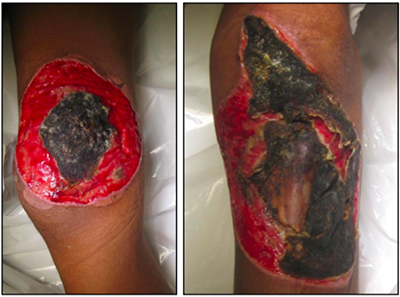Managing Neglected Burn Wound with Exposed Upper Tibia Using Multiple Modalities
DOI:
https://doi.org/10.14228/jpr.v2i3.244Abstract
Background: Deep burn wound with exposed underlying structures such as muscle or moreover in this case, bone, may increase morbidity in the terms of infection. Therefore careful planning of reconstruction is needed.
Patient and Method: We report one case of neglected burn wound with exposed tibia and muscle contracture on bilateral knee joint that was reconstructed in our Plastic Surgery Division of Prof RD Kandou Hospital. Data was taken from medical and surgery record.
Result: We managed the muscle contracture of the left knee joint by sedated gradual stretching and splinting. We also utilized hyperbaric treatment in order to maximize granulation process. A medial gastrocnemius muscle flap followed by split thickness skin graft is used to reconstruct the missing tissue at upper tibia, and another split thickness skin graft to cover another wound at opposite upper leg. The result was satisfying without any complication.
Conclusion: In managing a neglected burn wound with bone exposed and muscle contracture, it is compulsory to have a careful reconstruction planning. Our objectives are to release the muscle contracture and to provide an adequate coverage to the bone-exposed wound by using many modalities we have.

Downloads
Published
Issue
Section
License

This work is licensed under a Creative Commons Attribution-NonCommercial-NoDerivatives 4.0 International License.
Authors retain the copyright of the article and grant Jurnal Plastik Rekonstruksi the right of first publication with the work simultaneously licensed under a Creative Commons Attribution License. Articles opting for open access will be immediately available and permanently free for everyone to read, download and share from the time of publication. All open access articles are published under the terms of the Creative Commons Attribution-Non-commercial-NoDerivatives (CC BY-NC-ND) which allows readers to disseminate and reuse the article, as well as share and reuse of the scientific material. It does not permit commercial exploitation or the creation of derivative works without specific permission.













